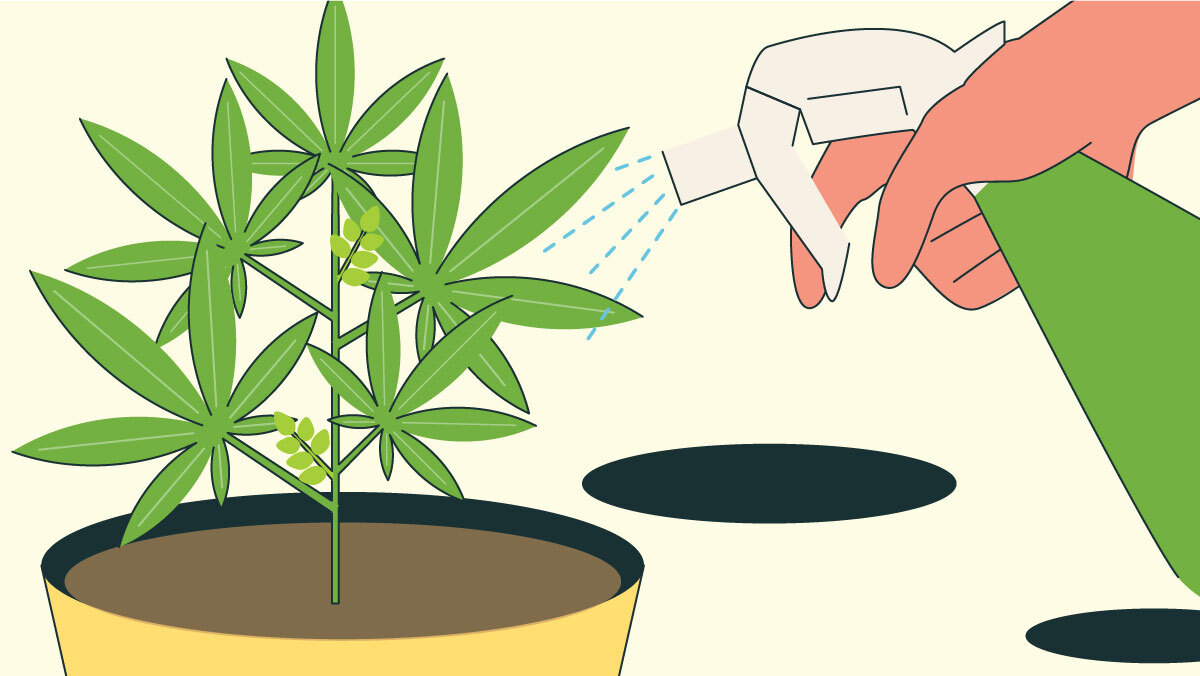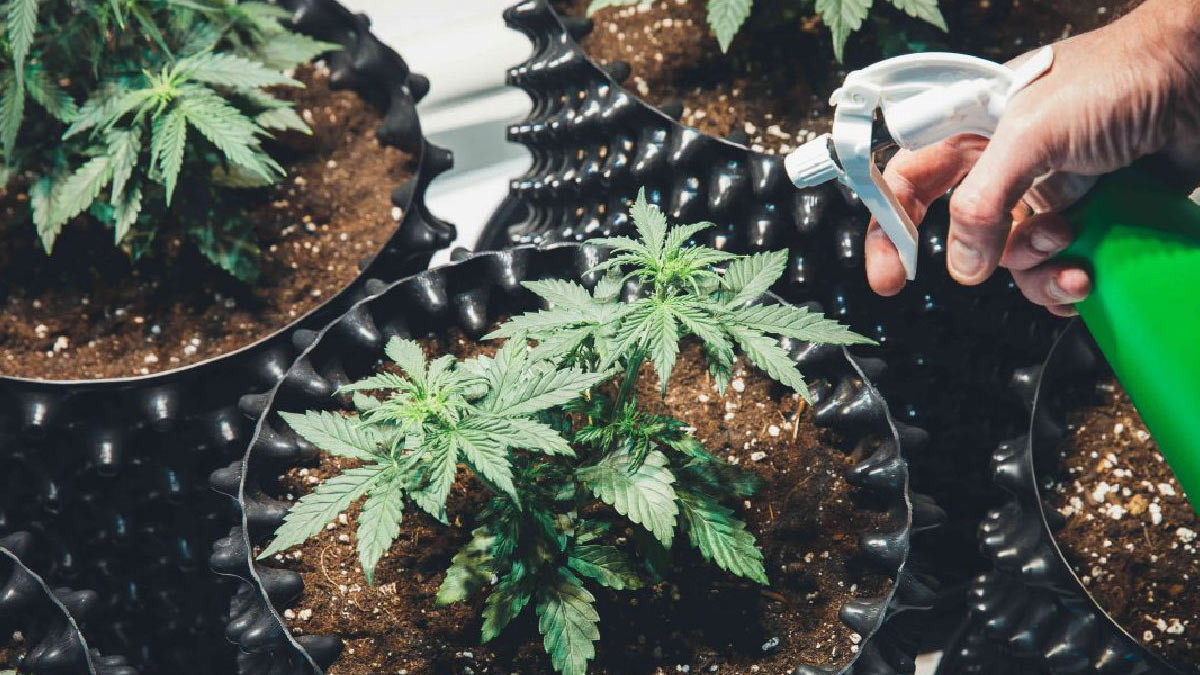Miracle-Gro Review: Is It Good for Your Cannabis Plant?

Many people decide to start their own grow once the weed has been legalized in their state.
The ones with beautiful backyard vegetable or herb gardens may figure they’re way ahead of the game; they’ll just use the same formula they’ve used for years. Their secret is rich soil, regular watering – and copious amounts of Miracle-Gro. Their friends and neighbors will be jealous, and they’ll have bountiful cannabis harvests with minimal effort.
They couldn’t be more wrong.
Let’s put aside the issue of how much work is really required to properly cultivate pot plants. That’s a story for another article. Instead, let’s focus on the belief that Miracle-Gro does exactly what its name implies, no matter what you’re growing.
It’s true that synthetic fertilizer can work wonders, whether you’re growing vegetables, flowers, or shrubs. Miracle-Gro provides substantial amounts of the nutrients that most plants need. And it’s earned its reputation for being able to turn “brown thumbs” into green ones.
You may not have noticed, but we deliberately said “most plants” in that last paragraph. That’s because Miracle-Gro isn’t a smart choice when you’re growing cannabis.
In fact, it may even completely ruin your grow.
Why Miracle-Gro Works in Most Gardens
Miracle-Gro is nothing more than water-soluble, synthetic fertilizer. Its primary ingredients are phosphorus, nitrogen, and potassium, the three macronutrients that most plants consume in large amounts in order to sustain their growth. It also contains a number of important micronutrients.
Plants initially get their food from the soil where they’ve been planted. But they use so much of those nutrients that even rich soil can quickly be depleted. That’s why the use of fertilizer is so important for healthy plant growth and the production of flowers, vegetables, and fruit.
There are several types of Miracle-Gro. They contain different proportions of macronutrients, designed to provide the “right” amount of nutrients for different types of plants. That’s what numbers like 15-30-15 mean; that fertilizer is 15% nitrogen, 30% phosphorus, and 15% potassium.
The company does an excellent good job of targeting its foods to the needs of specific plants, which is why Miracle-Gro has a deserved reputation of encouraging strong and rapid growth for most varieties of vegetables and flowers. It’s great for “set-it-and-forget-it” gardeners.
Organic and sustainable gardeners criticize the product for its chemical formulation, its effects on micro-organisms that live in soil, and the fact that using too much Miracle-Gro can burn plants.
Those aren’t the major reasons why Miracle-Gro is the wrong choice for weed plants, though.
Miracle-Gro and Cannabis: Why Not?
When you purchase a container of Miracle-Gro, its purpose is clearly labeled. For example, the company sells products like “Tomato Plant Food,” “Azalea, Camellia, Rhododendron Plant Food” and “Rose Plant Food.”
They can do that for the reason we mentioned earlier; the fertilizer is designed to provide the nutrients that a specific type of plant needs for its entire life cycle. That’s why you can pick up some Miracle-Gro for roses, and use it from early spring until the weather turns cold.
Here’s the big problem: marijuana plants have several, very different life cycle stages.
- Seedling stage: From the time you plant seeds until the pot plants are peeking through the growing medium, they really don’t need any fertilizer at all. They’ll get the nutrients they need from the soil. If any fertilizer is added in this stage, it should be a 1-1-1 formula and used very sparingly.
- Vegetative stage: This is when the plant really starts growing. Once it has sprouted its first set of fan leaves and leaflets, it’s appropriate to begin fertilizing it. During the vegetative stage, a cannabis plant needs all of the nutrients that most fertilizers provide: nitrogen, phosphorus, and potassium, as well as smaller amounts of other macro-and micronutrients. Experienced and commercial growers will alter the amount of each nutrient as the plant grows, but it’s not a requirement for home growers.
- Flowering stage: This stage begins when the pot plant begins to develop flowers and buds and lasts until harvest. At the start of the flowering stage, a plant needs less nitrogen, and more magnesium and calcium (a nutrient also contained in most fertilizers). And toward the end of the stage, it doesn’t want nitrogen at all. In fact, nitrogen can harm the plant and its product.
Most plants and vegetables don’t have that type of distinct life cycle. Giving them the same fertilizer from spring through fall won’t hurt them. But using the same fertilizer during a cannabis plant’s vegetative and flowering stages is a prescription for disaster.
Miracle-Gro is an “extended-release” product. In other words, it’s designed to release all of its nutrients – including nitrogen – for six months after it’s been introduced to the soil. And since the vegetative stage lasts for as few as four weeks before flowering begins (it can last ten weeks or even longer for some plants), that means the roots of pot plants will absorb large amounts of nitrogen long after nitrogen fertilizer should have to be tapered off and then discontinued.
What Can Happen to Cannabis Plants Fed With Miracle-Gro?

At first, they may prosper. Many home growers report that their plants have grown and prospered when fertilized with Miracle-Gro.
That is until they reach the flowering stage. That’s when the damage caused by nitrogen can become apparent.
- The plants’ growth may slow or stop completely.
- Leaves can begin showing signs of what’s called “nitrogen burn” or “nutrient burn,” typified by wilting, yellowing, or browning.
- The roots can turn brown or even black.
- Buds don’t grow as large, and the plant’s yield is greatly reduced.
- Some even say that the final product winds up with a harsh, chemical taste.
Most of those effects are caused, of course, by nitrogen. A contributing factor, though, is that Miracle-Gro doesn’t provide enough of the other important nutrients a pot plant needs for flowering.
Will using Miracle-Gro definitely destroy your weed crop? Not necessarily, but chances are good that it will damage it.
There are much better choices.
Alternatives to Miracle-Gro for Cannabis
The best fertilizers for pot plants are actually sold in packages containing several different products: one for the vegetative (or growing) stage, and another for the flowering stage. Some also have a gentle fertilizer to be used during the seedling stage. Brands to check out include Bergman’s Marijuana Fertilizer and FoxFarm Trio Pack.
Once you’ve gained a little experience, you may want to adjust the nutrients you feed your plants more frequently. BioBuzz sells fertilizers for the two major stages, plus substrates and other soil additives that optimize plants’ growth and production. The Advanced Nutrients Starter Kit has even more goodies you can mix and match to fit the characteristics of your grow.
Or if you’re the totally-natural type, you can use fertilizers like wood ash, worm castings, bat guano, compost, and even human urine to feed your weed plants. If that sounds good to you, you’ll find plenty of advice online, but not here. Best of luck with it, though!
Miracle-Gro for Cannabis FAQ
Q: If Miracle-Gro can work well during the vegetative stage, is there anything wrong with using it until flowering begins and then switching to another fertilizer?
A: Yes, unless you’re planning to transplant your crop at the same time. Miracle-Gro stays in the soil and continues to release nitrogen and do damage until well after you’ve collected your harvest.
Q: Are there any full-season fertilizers designed for pot plants?
A: There are some marketed that way. But they’re either intended for general use and don’t have the right mix of nutrients for each stage of the growing process, or they rely on ingredients like microbes and fungi and won’t be “enough” to keep your plants healthy and as productive as they should be. Your best bet is one of the kits with several different fertilizers; all you have to do is switch to a different container midway through the season.
Q: Can Miracle-Gro damage other plants the same way it can damage cannabis plants?
A: It can, if you use too much. If you’re one of the people who regularly use it on tomato or rose plants, don’t be dissuaded by the effect it can have on pot plants. Just follow the directions on the package and you should be fine. (There are environmental arguments that some people make against the use of Miracle-Gro, but that’s a different matter entirely.)